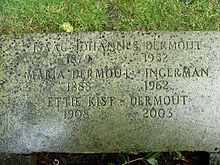| This article needs additional citations for verification. Please help improve this article by adding citations to reliable sources. Unsourced material may be challenged and removed. Find sources: "Maria Dermoût" – news · newspapers · books · scholar · JSTOR (April 2008) (Learn how and when to remove this message) |
| Maria Dermoût | |
|---|---|
 Maria Dermoût in 1907 Maria Dermoût in 1907 | |
| Born | Helena Anthonia Maria Elisabeth Ingerman (1888-06-15)15 June 1888 Pati, Dutch East Indies |
| Died | 27 June 1962(1962-06-27) (aged 74) The Hague, Netherlands |
| Occupation | Novelist |
| Signature | |
 | |
Maria Dermoût (15 June 1888 – 27 June 1962) was an Indo-European novelist, considered one of the greats of Dutch literature and as such an important proponent of Dutch Indies literature. In December 1958 Time magazine praised the translation of Maria Dermoût's The Ten Thousand Things, and named it one of the best books of the year.
Whitney Balliett of The New Yorker wrote:
"Mrs. Dermout, in the manner of Thoreau and the early Hemingway, is an extraordinary sensualist. in passages of a startling, unadorned, three-dimensional clarity; often one can almost touch what she describes."
Biography
Helena Anthonia Maria Elisabeth Ingerman was born on 15 June 1888 on a sugar plantation in Pati, Java, Dutch East Indies, and educated in the Netherlands. She wrote in Dutch. After completing her education she returned to Java, where she married Issac Johannes Dermoût and became known as Maria Dermoût. She travelled extensively across Java and the Moluccas with her husband. In 1933 her husband retired, and the couple settled in the Netherlands. Maria Dermoût was widowed in 1952.
Maria Dermoût died in The Hague on 27 June 1962. She is the subject of the biography Geheim Indië. Het leven van Maria Dermoût 1888-1962 ("The Secret East Indies. The Life of Maria Dermoût 1888-1962") in 2000 by the Indo-European (Dutch-Indonesian) author Kester Freriks.
Body of work
Dermoût turned to writing early in life, but remained largely unpublished until she was 63. She wrote two novels, both of which were not published until she was in her sixties: The Ten Thousand Things (De tienduizend dingen, 1955) and Days Before Yesterday — also published as Just Yesterday (Nog pas gisteren, 1951). There are English translations of her novels by Hans Koning. Some of her short stories were published in translation in magazines such as Vogue during the 1960s. In Dutch, five short-story collections by her were also published.
She is viewed as one of the giants among Dutch-Indies literary writers, and The Ten Thousand Things in particular is widely regarded as an idiosyncratic masterpiece. The book has been translated into thirteen languages. As Hans Koning puts it in his Introduction to the New York Review Books edition of the novel:
"Dermoût was sui generis, a case all her own. She did not write about her Indies as a Dutch woman, or as a Javanese or an Ambonese. Hers was a near-compassionate disdain for the dividing lines, the hatreds and the fears ... She painted landscapes, still lifes and people in a world of myth and mystery."
Although not conventionally autobiographical, both of her novels draw from events in Dermoût's own life. Like the central character in The Ten Thousand Things, Dermoût lost her son in violent circumstances (he died in a Japanese prisoner-of-war camp). The reminiscences of Javanese childhood experiences described in Days Before Yesterday are based on, but do not mirror, her own childhood in the tropics.

Author Oek de Jong appropriately wrote:
"Still, Maria Dermoût an author for the happy few. Is she a writer's writer? Certainly not. She is a storyteller par excellence. Her stories are subtle, but they are also accessible. Nonetheless she remains an author for the happy few, equal to the greats of Dutch prose, but much less known than they are. There are many reasons for her modest literary reputation: her own modesty, the small body of her work, the brevity of her literary career. But it is mainly her work itself that is the cause. It possesses something that wards off hordes of readers, yet still manages to attract a handful, who then embrace it and spread the word of its exquisite nature. The shell seekers among the readers, the slow walkers, those who stop and turn and bend over to pick up that one beautiful shell - they recognize her extraordinary work."
References
- New York Review Books website. Retrieved 26 October 2011
- ^ "Maria Dermout". New York Review Books. Retrieved 2021-01-08.
- Encyclopædia Britannica "Her first two novels, Nog pas gisteren (1951; Yesterday) and De tienduizend dingen (1955; The Ten Thousand Things), are fictionalized accounts of her youth. Although written in an economic style, the two novels are rich in details of island life as experienced by both the colonials and the native people"
- Jong, Oek de. Oek de Jong leest Maria Dermoût. (Amsterdam, 2005) P.7-8
External links
- Maria Dermout website.(in Dutch)
- Doolan, Paul (2013). "Maria Dermoût and 'Unremembering' Lost Time" (PDF). Canadian Journal of Netherlandic Studies. 34 (2): 1–28. Retrieved 14 September 2015.
- 1888 births
- 1962 deaths
- 20th-century Dutch East Indies people
- People from Pekalongan
- Indonesian women novelists
- Novelists from the Dutch East Indies
- Indonesian people of Dutch descent
- Indo people
- 20th-century Dutch novelists
- 20th-century Dutch women writers
- Dutch women novelists
- 20th-century Indonesian women writers